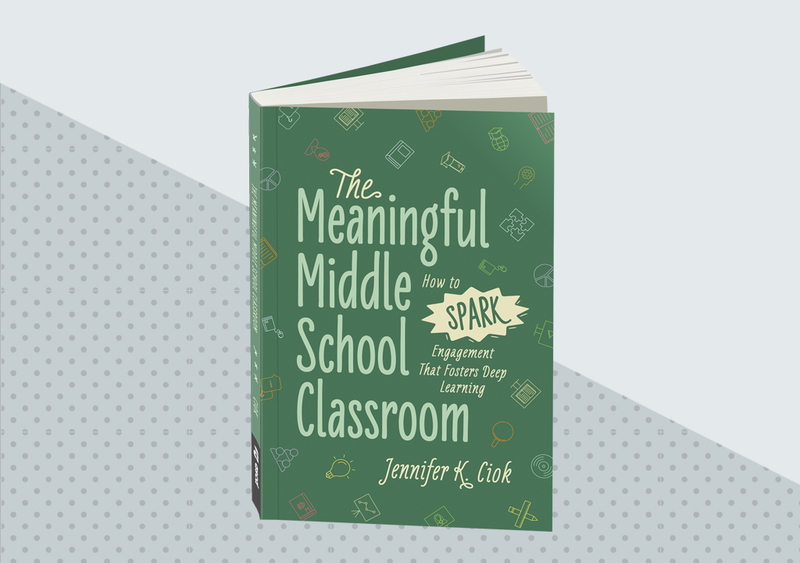Middle school represents a pivotal moment in students' development—a time when they begin asking deeper questions, seeking greater meaning, and facing new social and academic pressures. Unfortunately, it's also when classroom engagement often begins to wane.
In The Meaningful Middle School Classroom: How to Spark Engagement That Fosters Deep Learning, educator Jennifer K. Ciok addresses this challenge head-on, drawing from more than 25 years of experience to offer practical approaches that reconnect students with their learning. Ciok shares that meaningful education requires consistent, intentional effort to help early adolescents see themselves and their experiences reflected in their learning.
This excerpt provides teachers with accessible frameworks that make such connection-building a regular part of classroom life, ensuring that middle school students receive the support they need during this critical developmental stage.
A Calendar of Connection
Helping students to connect to their learning can't be a once-a-month or once-a-quarter thing. As a teacher, take at least five minutes every day to plan how to help students create those meaningful connections. Whether it's through storytelling, the arts, or tying a topic to something in their life outside school, the sense-making that comes from those intentional activities will help students remember what they learned, connect it to other learning, and see ways to integrate it into their lives.
Intentional activities will help students remember what they learned, connect it to other learning, and see ways to integrate it into their lives.
One way to be intentional about this "spark time" is to create weekly themes or a monthly calendar to make the effort visible to students. For each of these ideas, students can share their thoughts in pairs or small groups, through a collective or individual written response, or as a whole class. For example, a weekly calendar could include days of the week that focus on a different theme:
- Meaningful Monday: Have students share one thing that they learned the week before or in the unit you are currently studying that they used outside school.
- Talented Tuesday: Have students connect a form of art to the content you are learning. This could be a piece of art that they find or something that you have them react to or create.
- Why Wednesday: Give students a dedicated opportunity to ask questions about what they are learning. The questions could be about things they find confusing, places where they need additional information, or the ever-present "Why are we learning this?" question. Some students can be apprehensive about asking for help, so giving them the opportunity to do this every week can make the practice more routine and help all students to advocate for what they need.
- Talkative Thursday: Have students share a story about themselves related to the content they are learning or something that is happening in the school.
- Facts and Figures Friday: Share data from the week with your students to gather additional feedback from them on one or more aspects of your class. This data could come from a more formal survey regarding classroom culture. But it also could be looking at one question that many students missed on an assessment or an assignment that many students didn't turn in to find out why. Make sure this is information that you are ready to hear and that you do this in such a way that the students feel that their voice will be valued and that their thoughts and opinions will be heard and acted upon.
If monthly themes fit better into your planning, here are examples of specific focuses for each month:
- Storytelling September: To build connections to start the year, use this month to have students share their own stories in a variety of ways.
- Options and Opportunities October: Giving options and new opportunities to your students could be as simple as letting them choose which question they answer as an opener. Having students making choices about what works best for them gives them more confidence and allows them to see that their opinions have value.
- Noticings November: Take time each day to gather noticings, opinions, and ideas from students. These might be about how their first months of school have gone or what they thought of a particular assignment or project. Soliciting your students' voices early and often will give them practice in sharing their thoughts and feelings throughout the year.
- Data Dive December: As the first semester comes to an end, use this month to share data with students and gather additional feedback from them to make changes for the second semester.
- Journaling January: The beginning of the calendar year is always a good time to reflect on the year that has just ended and set goals for the new year. Throughout January, give students the opportunity to engage in a dialogue journal with you or reflect on goals they set for themselves. The second semester in any grade in middle school often sees big changes, especially as 6th graders are getting comfortable with being middle schoolers, 7th graders are thinking about what it will mean to be the oldest students in the building in just a few short months, and 8th graders are thinking about high school. Journaling can give students the opportunity to share their thoughts, and it allows teachers to gain insights into how students are feeling.
- Flair February: February can be a tough month at school. It can be cold and dreary, depending on your location, or maybe it's just the time of year that seems to drag. Use this month to brighten up your curriculum by intentionally sharing art that connects to the students' learning each day. The "flair" that comes from visual art, music, cartoons, photographs, and other forms can revitalize this time of year and give students landmarks to connect their learning to.
- March Madness: Playing off the annual basketball tournament, create a bracket of various activities for students to do each day that connect to your curriculum. An example of this could be a storytelling activity versus an art activity, or a drawing activity versus a music activity. Throughout the month, have students choose (and do!) the activity, while voting along the way to get to a final winning activity that students connected to the most. This activity allows you to revisit themes from the past months and see what really stuck with students or what they found most engaging throughout the year.
- Advice April: Throughout the month, have students do a series of reflection activities, beginning with the advice they would give to students coming into the grade or class. Then have them think about things that they wish they had known before starting the year. Find ways to share the insights with incoming students, whether through short videos or writing or even presenting to their younger peers, if possible. These activities can be beneficial for both you as the teacher and for your current and future students. They give students the opportunity to reflect on how they have grown throughout the year, what changes they have made, and points at which they wish they had done something differently. For you as the teacher, hearing this advice can help you to think differently about how to welcome students into your classroom, or it can help you to consider small changes that can help students be more successful.
- Making Meaning May: As the year comes to an end, May is a good time to review everything students have learned during the year, have them create a through-line between the different units, and think about how the skills and topics they learned about in all their classes connect to one another. This thematic focus helps to build relevancy and student understanding of the interconnectedness of the various elements of their learning.
The Meaningful Middle School Classroom
Explore ways to spark engagement in the middle school classroom with this practical and inspiring guide.









